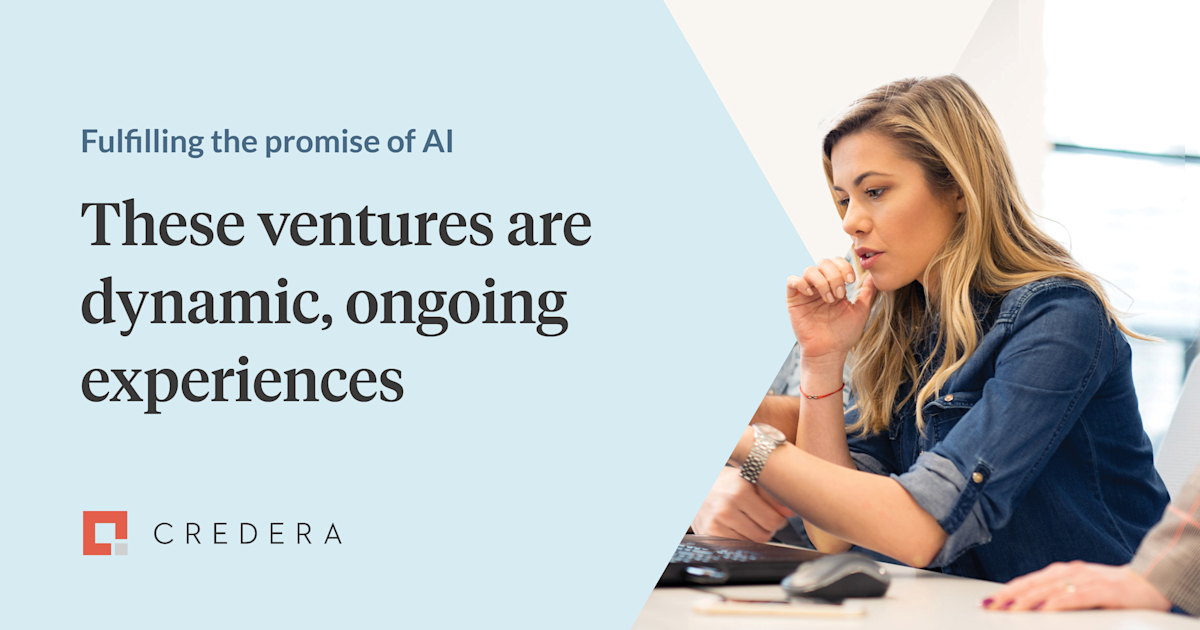
With typical projects, the ideal result is defined from the outset, based on specific business requirements. AI projects are different. The key to understanding AI today is to focus on the "learning" in machine learning, not the "intelligence" in artificial intelligence.
For instance, an organization implementing an AI-powered customer service chatbot may initially expect the chatbot to handle simple queries. However, as the chatbot interacts with customers and learns from each interaction, it may uncover new use cases and potential improvements, leading to the continuous development and evolution of the chatbot's capabilities.
The nature of AI is that it’s designed to learn and adapt, which means the final value of the project is often even beyond the business value identified at the beginning of the project. In this sense, AI projects should be seen as continuous processes rather than one-time implementations.
The success of an AI project should be measured in terms of the ongoing business value it delivers, rather than just the initial implementation, and teams should expect to continue to reassess this business value as the project progresses. This highlights the dynamic and evolving nature of AI projects, which require ongoing attention and evaluation to ensure they continue to provide increasing value.
Start with business value and measurement
The foundation of any successful project is a clear understanding of the business value it aims to deliver and how that value will be measured. Establishing metrics and key performance indicators (KPIs) from the beginning allows you to track progress and make data-driven decisions. This looks different in an AI project compared to a traditional one because the value evolves over time, but business value still must be measurable to ensure the project is driving valuable outcomes.
Let's say a company is implementing an AI project to improve customer service efficiency. The business value in this case could be reducing customer service response times by 20%, and the measurement would involve tracking the average response time before and after implementation to ensure that the business value is being achieved.
Prepare for continuous monitoring and adaptation
AI projects must be continuously monitored and adapted for several reasons:
Drift: Customer needs and market dynamics are always changing. Businesses need to continuously monitor AI systems to ensure they remain aligned with these changing market conditions. Otherwise, models may be training off of stale assumptions, leading to outdated results. Early detection of shifts in customer preferences or market trends lets you adapt your AI systems to remain relevant and effective.
Underlying systems and data shifts: The data AI models rely on can also change over time due to various factors, such as moves to new platforms, additions of new tools, or industry changes. These shifts can impact the performance of AI models, making it essential for organizations to regularly update and recalibrate their AI systems to ensure accurate and reliable results.
Rapid technology changes: To maintain a competitive edge, you need to stay up-to-date on the latest advancements in AI technology and incorporate them into your AI projects. Continuous monitoring and adaptation allow you to leverage the most recent AI capabilities and tools, enhancing the effectiveness and efficiency of your AI systems.
Implement your AI project process
Because AI projects differ from traditional projects in that there’s continuous testing, experimentation, and evolution, rather than a single implementation, more iteration cycles are needed in each step of the process. Here’s how your AI project process should be structured:
Start with a hypothesis: Formulate a clear, specific statement around what you aim to achieve; it should be closely aligned with your business objectives and outline the expected business value. For example, if the objective is to enhance customer satisfaction through AI, the hypothesis could be based on improving the accuracy of personalized product recommendations.
Define your audience segments: Segmenting your audience is essential for tailoring AI models to specific user groups. By identifying distinct audience segments, you can customize the AI models to better meet the needs and preferences of each segment.
For instance, an ecommerce platform may have different audience segments, such as new customers, loyal customers, and bargain hunters. Understanding these segments enables the customization of AI models to provide more relevant and personalized experiences.
Conduct A/B testing: A/B testing involves comparing two versions of something to determine which performs better. For AI projects, this could mean testing different machine learning models, algorithms, or approaches to see which yields more accurate results or better aligns with the desired outcomes. A/B testing allows for empirical evaluation of different AI models, helping identify the most effective approach.
Learn from the results: Analyze the results to gain insights to refine your understanding of the problem space and make informed decisions about model selection, feature engineering, and other aspects of the AI project.
Iterate: This involves refining the models, making adjustments, and incorporating new learnings to improve accuracy and effectiveness. Through iteration, AI projects evolve and grow more robust over time, enabling continuous improvement and adaptation to changing requirements and conditions.
The bottom line
Treating AI projects as ongoing experiences focused on delivering measurable business value ensures that your AI initiatives remain relevant, effective, and aligned with your business goals. If your organization needs guidance in crafting and implementing new processes, Credera’s specialists can help.
Most consultancies want to help you identify what’s holding you back and give you generic, high-level solutions, but we’ll work with you to develop a specific, actionable plan you can follow, with realistic, detailed solutions to your AI-related issues. Schedule a call to get started.
Contact Us
Let's talk!
We're ready to help turn your biggest challenges into your biggest advantages.
Searching for a new career?
View job openings


